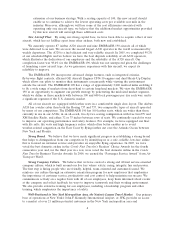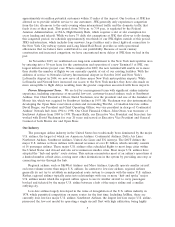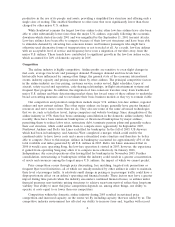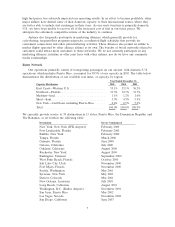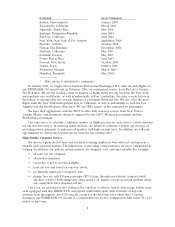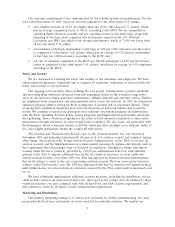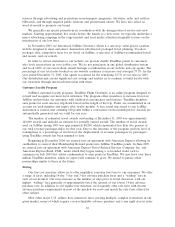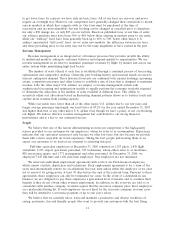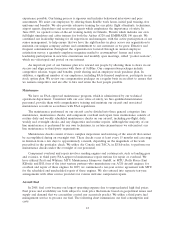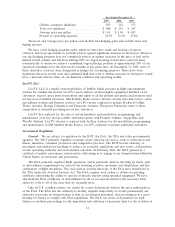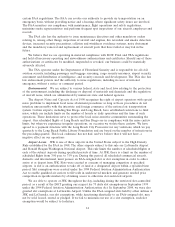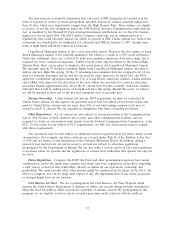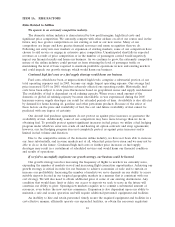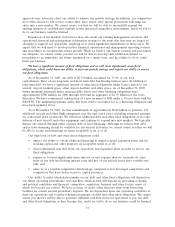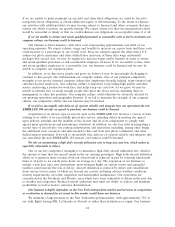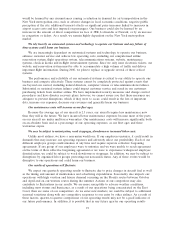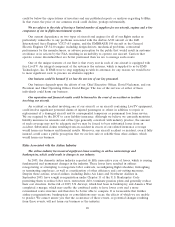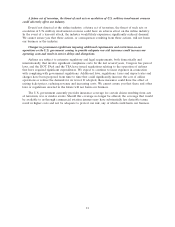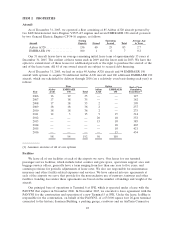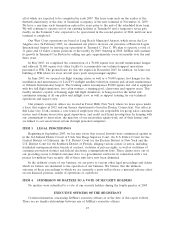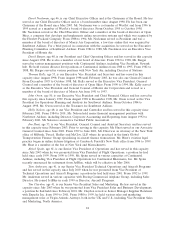JetBlue Airlines 2005 Annual Report Download - page 22
Download and view the complete annual report
Please find page 22 of the 2005 JetBlue Airlines annual report below. You can navigate through the pages in the report by either clicking on the pages listed below, or by using the keyword search tool below to find specific information within the annual report.certain FAA regulations. The FAA can revoke our authority to provide air transportation on an
emergency basis, without providing notice and a hearing, where significant safety issues are involved.
The FAA monitors our compliance with maintenance, flight operations and safety regulations,
maintains onsite representatives and performs frequent spot inspections of our aircraft, employees and
records.
The FAA also has the authority to issue maintenance directives and other mandatory orders
relating to, among other things, inspection of aircraft and engines, fire retardant and smoke detection
devices, increased security precautions, collision and windshear avoidance systems, noise abatement
and the mandatory removal and replacement of aircraft parts that have failed or may fail in the
future.
We believe that we are operating in material compliance with DOT, FAA and TSA regulations
and hold all necessary operating and airworthiness authorizations and certificates. Should any of these
authorizations or certificates be modified, suspended or revoked, our business could be materially
adversely affected.
The TSA operates under the Department of Homeland Security and is responsible for all civil
aviation security, including passenger and baggage screening, cargo security measures, airport security,
assessment and distribution of intelligence, and security research and development. The TSA also has
law enforcement powers and the authority to issue regulations, including in cases of national
emergency, without a notice or comment period.
Environmental. We are subject to various federal, state and local laws relating to the protection
of the environment, including the discharge or disposal of materials and chemicals and the regulation
of aircraft noise, which are administered by numerous state and federal agencies.
The Airport Noise and Capacity Act of 1990 recognizes the right of airport operators with special
noise problems to implement local noise abatement procedures as long as those procedures do not
interfere unreasonably with the interstate and foreign commerce of the national air transportation
system. Certain airports, including San Diego and Long Beach, have established restrictions to limit
noise, which can include limits on the number of hourly or daily operations and the time of such
operations. These limitations serve to protect the local noise-sensitive communities surrounding the
airport. Our scheduled flights at Long Beach and San Diego are in compliance with the noise curfew
limits, but when we experience irregular operations, on occasion we violate these curfews. We have
agreed to a payment structure with the Long Beach City Prosecutor for any violations, which we pay
quarterly to the Long Beach Public Library Foundation and are based on the number of infractions in
the preceding quarter. This local ordinance has not had, and we believe that it will not have, a
negative effect on our operations.
Airport Access. JFK is one of three airports in the United States subject to the High Density
Rule established by the FAA in 1968. The other airports subject to this rule are LaGuardia Airport
and Ronald Reagan Washington National Airport. This rule limits the number of scheduled flights at
each of the subject airports during specified periods of time. At JFK, there is a limit on the number of
scheduled flights from 3:00 p.m. to 7:59 p.m. During this period, all scheduled commercial aircraft,
domestic and international, must possess an FAA-assigned slot or slot exemption in order to either
arrive at or depart from JFK. Slots were created as a means of managing congestion at specified
airports. A slot is an authorization to take off or land at a designated airport within a specified time
period. Slot exemptions were created under the 1994 Federal Aviation Administration Authorization
Act to enable qualified air carriers to fill voids in underserved markets and generate needed price
competition in specific markets by obtaining access to otherwise slot-restricted airports.
We are able to operate at JFK throughout the day, including during the restricted slot-controlled
period, as a result of the DOT granting our request for 75 daily slot exemptions in September 1999
under the 1994 Federal Aviation Administration Authorization Act. In September 2004, we were also
granted slot exemptions at LaGuardia Airport. Unlike the FAA-assigned slots held by other airlines at
JFK and LaGuardia, our slot exemptions, while functioning identically to an FAA-assigned slot, may
not be sold, leased, rented or pledged. If we fail to maintain our use of a slot exemption, such slot
exemption would be subject to forfeiture.
14


